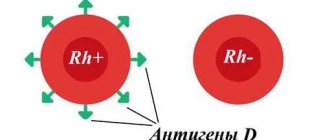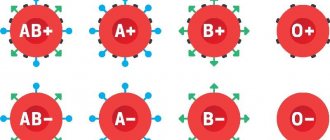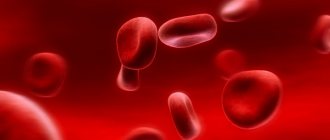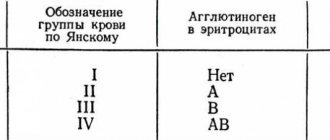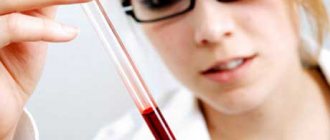Blood type can tell you a lot about a person. As a rule, it determines his character. The blood type remains unchanged throughout life, performing its main function, which is to support the vital functions of the human body.
Thus, a man and a woman must have perfect compatibility before planning a child. Blood type 4 positive is considered the rarest. It consists of AB antigens. Among the people it is also called mixed.
How did the fourth group appear?
It is believed that during the formation of human society, gene mutations occurred. This also applied to blood type. The fourth one arose last as a variant of the second and third. About a thousand years ago there was a mixing of the genetic groups of Indo-Europeans and Mongols.
It has been established that there are spots of this particular group on the Shroud of Turin. This makes it possible to classify Jesus Christ as a bearer of rare blood.
Children can get AB (IV) if the parents have the second or third group, and this type will never be formed if one of the parents has the first group.
The laws of inheritance are studied by medical genetics and used in judicial practice.
Why is it important to know your blood type?
Determining blood group compatibility is necessary, first of all, for transfusion (blood transfusion). Large blood loss is deadly. Since ancient times, attempts have been made to compensate for blood loss by infusing the blood of another person. But the first blood you come across cannot be used. When mixing blood “blindly,” in about half of the cases, agglutination occurs: red blood cells (erythrocytes) begin to stick together, forming clumps. The flakes resulting from agglutination are visible in a test tube with the naked eye; it is clear that if this process happens inside the circulatory system, nothing good can be expected for a person.
Agglutination
At the beginning of the 20th century, it was established why agglutination occurs. On the surface of the erythrocyte (red blood cell) membrane there are special antigen proteins (they are called agglutinogens). They are called antigens because they can bind to other substances - antibodies. This connection is specific, that is, a given antigen can only be bound by a specific antibody. When we talk about blood groups, we use a system that is only interested in two antigens (in fact, there are many more of them “riding” on red blood cells). For convenience, these antigens (agglutinogens) are designated by the first letters of the Latin alphabet - A and B. The corresponding antibodies (they are called agglutinins) are designated by the first letters of the Greek alphabet - α (alpha) and β (beta).
Obviously, an antigen and its corresponding antibody cannot be present in the blood at the same time, otherwise a reaction (agglutination) would occur. But other combinations are possible. They are the ones who determine which group our blood belongs to.
What kind of blood can be transfused?
Transfusion of fresh blood is prohibited by the Instructions of the Ministry of Health. Only red blood cells or other blood products are allowed to be used. But doctors know emergency situations in case of injuries, heavy bleeding, when a person’s life depends on the urgency of replenishing the bloodstream. In such cases, even direct transfusion from donor to recipient is justified.
In an emergency, the blood transfusion station prepares its supplies of blood substitutes and calls donors
Since it is very difficult to find a single donor for an AB (IV) Rh (-) case, transfusion of any Rh-negative blood is suitable. In this sense, people with the fourth group are considered “universal”. Because they already have agglutinogens A and B, additional administration from the second and third groups will not cause a reaction, and in the first group there are none at all.
A test for individual compatibility is mandatory, even with a planned transfusion.
Some facts
Representatives of the fourth blood group in question are distinguished by their endurance. They can easily adapt to completely new climate and living conditions. In addition, such people calmly tolerate changes in diet. Therefore, the diet is not scary for them.
Resistance to all kinds of diseases is also observed. As for the digestive system, it is sensitive in owners of blood group 4. Therefore, most people require a diet. Another well-known fact is that Jesus Christ had the fourth blood type. True, there is no exact confirmation of this.
The characteristics of people of this blood group are as follows. They are calm, tactful, balanced and friendly. In addition, such a person has sociability, he will easily get along with other people. Sadness and depression visit him quite rarely.
Despite the external positivity and balance, the inner world of these people is full of worries. They are often afraid of making mistakes and making the wrong decision. Sometimes it is quite difficult for them to decide something. In order to suppress anxiety within oneself, active mental activity is used, various physical activities are performed that can take away a large amount of energy. People with blood type 4 are subject to mysticism. Thus, they are often able to foresee various events.
The fourth blood group, as a rule, belongs to creative people.
The following plays a big role in their lives:
- emotionality;
- fantasy;
- perfect taste;
- sincerity;
- love for everything beautiful;
- developed intuition.
Due to their sophisticated perception of reality, such people are capable of going to extremes. Under the influence of intense emotions, they sometimes fail to gain control over themselves. A person who has compatibility of A and B antigens often creates idols for themselves. They are characterized by absent-mindedness, impracticality, they are not always ready to solve problems that arise, and are sensitive to insults.
Problems during pregnancy
For a pregnant woman with positive Rh and blood type IV, problems can only arise with bleeding during childbirth. Because there are difficulties with selecting donors.
During pregnancy, special conditions arise only if the mother does not have Rh in the blood and the father is Rh positive. In this case, the child can choose the man’s genes, and the mother’s body will begin to produce antibodies to the fetus.
If the child prefers the maternal genes, then this will not affect the pregnancy at all.
This reaction is called a “Rh conflict”. It is dangerous for both the mother and the unborn baby. The formation of organs and systems of the fetus is disrupted. There is a predisposition to interruption in the early stages.
During the first pregnancy, a sufficient level of antibodies accumulates only towards the end of the term, and the child’s body is minimally affected. The situation is especially dangerous during the second and subsequent pregnancies, which do not necessarily result in childbirth. Even after an abortion, antibodies have already appeared in the body of a Rh-negative woman. They begin to attack the unprotected fetus and cause complete rejection.
INHERITANCE OF BLOOD TYPE BY A CHILD
Often in the maternity hospital, mothers are asked the question: “What cut group does my child have?” And then they think long and painfully: “Why did they say that my baby has the first blood type, if my husband and I have the second?”
To answer this question, let us remember what blood groups are and what laws of nature they “obey”.
At the beginning of the last century, scientists proved the existence of 4 blood groups.
The Austrian scientist Karl Landsteiner, mixing the blood serum of some people with red blood cells taken from the blood of others, discovered that with some combinations of red blood cells and serum, “gluing” occurs - red blood cells stick together and form clots, but with others - not.
While studying the structure of red blood cells, Landsteiner discovered special substances. He divided them into two categories, A and B, highlighting a third, where he included cells that did not contain them. Later, his students - A. von Decastello and A. Sturli - discovered red blood cells containing A- and B-type markers simultaneously.
As a result of research, a system of dividing blood groups emerged, which was called ABO. We still use this system today.
- I (0) – blood group is characterized by the absence of antigens A and B;
- II (A) – established in the presence of antigen A;
- III (AB) – B antigens;
- IV(AB) – antigens A and B.
The AB0 system has revolutionized scientists' understanding of the properties of blood. Genetic scientists began to study them further. They proved that the principles of inheritance of a child's blood type are the same as for other characteristics. These laws were formulated in the second half of the 19th century by Mendel, based on experiments with peas, familiar to all of us from school biology textbooks.
So how are blood groups inherited by a child according to Mendel’s law?
- According to Mendel's laws, parents with blood group I will give birth to children who lack A- and B-type antigens.
- Spouses with I and II have children with the corresponding blood groups. The same situation is typical for groups I and III.
- People with group IV can have children with any blood group, with the exception of I, regardless of what type of antigens are present in their partner.
- The inheritance of a blood group by a child is most unpredictable when the union of owners with groups II and III occurs. Their children are equally likely to have any of the four blood types.
- The exception to the rule is the so-called “Bombay phenomenon”. Some people have A and B antigens in their phenotype, but do not manifest themselves phenotypically. True, this is extremely rare and mainly among Indians, which is why it got its name.
TABLE OF INHERITANCE OF BLOOD TYPE BY A CHILD DEPENDING ON THE BLOOD GROUPS OF THE FATHER AND MOTHER
| MOM + DAD | CHILD'S BLOOD TYPE : POSSIBLE OPTIONS (%) | |||
| I+I | I (100%) | — | — | — |
| I+II | I (50%) | II (50%) | — | — |
| I+III | I (50%) | — | III (50%) | — |
| I+IV | — | II (50%) | III (50%) | — |
| II+II | I (25%) | II (75%) | — | — |
| II + III | I (25%) | II (25%) | III (25%) | IV (25%) |
| II + IV | — | II (50%) | III (25%) | IV (25%) |
| III+III | I (25%) | — | III (75%) | — |
| III + IV | — | I (25%) | III (50%) | IV (25%) |
| IV + IV | — | II (25%) | III (25%) | IV (50%) |
INHERITANCE OF RH FACTOR
The birth of a child with a negative Rh factor in a family of Rh-positive parents causes deep bewilderment at best, and mistrust at worst. Reproaches and doubts about the fidelity of the spouse. Oddly enough, there is nothing exceptional in this situation. There is a simple explanation for such a delicate problem, which is based on the same laws of genetics.
The Rh factor is a lipoprotein located on the membranes of red blood cells in 85% of people (they are considered Rh positive). If it is absent, they speak of Rh-negative blood. These indicators are denoted by the Latin letters Rh with a plus or minus sign, respectively.
The gene for a positive Rh factor is designated D, it is a dominant trait (always appears). The Rh negative gene is recessive and is designated d (appears only in the absence of D). Therefore, people with a set of DD or Dd chromosomes will have Rh positive blood, and only those with a dd chromosome set will have Rh negative blood.
Consequently, parents with a homozygous absence of the Rh factor (dd) can only give birth to children with Rh negative blood.
Parents with homozygous Rh positive factor (DD) will only give birth to children with Rh positive blood.
But in the union of people with Rh positive blood with heterozygous presence of Rh (Dd), their children will have Rh positive in 75% of cases and negative in the remaining 25%.
So, parents: Dd x Dd. Children: DD, Dd, dd – these are Rh negative children of Rh positive parents! .
Inheritance of the blood type of the Rh system, possible in a child, depending on the blood groups of his parents.
| Mother's blood type | Father's blood type | |
| Rh(+) | rh(-) | |
| Child's blood type | ||
| Rh(+) | Any | Any |
| rh(-) | Any | Rh negative |
And some more interesting things from geneticists...
INHERITANCE OF CHARACTERISTICS
For centuries, parents have only wondered what their child would be like. Today is an opportunity to look into the future. Thanks to ultrasound, you can find out the gender and some features of the anatomy and physiology of the baby.
Genetics will make it possible to determine the likely color of the eyes and hair, and even whether the baby has an ear for music. All these characteristics are inherited according to Mendelian laws and are divided into dominant and recessive.
Brown eye color, hair with small curls, and the ability to roll the tongue into a tube are dominant signs. Most likely, the child will inherit them. Unfortunately, dominant signs also include a tendency to early baldness and graying, myopia and gaps between the front teeth.
Gray and blue eyes, straight hair, fair skin, and a mediocre ear for music are considered recessive. These signs are less likely to occur.
BOY OR...
For many centuries, the blame for the lack of an heir in the family was placed on the woman. To achieve the goal of having a boy, women resorted to diets and calculated favorable days for conception. But let's look at the problem from a scientific point of view. Human sex cells (eggs and sperm) have half the set of chromosomes (that is, there are 23 of them). 22 of them are the same for men and women. Only the last pair is different. In women these are XX chromosomes, and in men they are XY.
So the probability of having a child of one sex or another depends entirely on the chromosome set of the sperm that managed to fertilize the egg. To put it simply, the father is entirely responsible for the gender of the child!
Head of the department for newborn children Ilkevich N.G.
Neonatologist of the department for newborn children Valentyukevich T.S.
Prevention
To prevent such unexpected situations, obstetricians and gynecologists check whether the parents are matched by Rhesus. All adults are advised to know their blood type and Rh.
Antibodies are examined by immunological tests
During pregnancy, it is necessary to determine the onset of antibody production as early as possible. To do this, the woman is sent for a specific blood test.
Women with group AB (IV) Rh (-) are recommended to administer anti-Rhesus globulin in the first three days after abortion or childbirth. The technique has proven itself and allows you to have two or more children.
In the case of AB (IV) and positive Rh, the expectant mother does not have such problems, even if the father does not have Rh.
Blood type 4 is positive in children, women and men: what should be taken into account when transfusion
Karl Landsteiner's discoveries were important for the successful implementation of blood transfusions, since they help to avoid conflicts between the donor and recipient blood. Ignoring group and Rh compatibility during transfusion can end very badly for the recipient - coma and even death.
Read also: How to determine blood group using standard sera, methods and features of the procedure
People with AB+ are in a relatively favorable position during blood transfusion. They are universal recipients because there are no antibodies in their blood. Blood of any type is suitable for them.
The only problem is that the donor is Rh negative. But there are much fewer people with Rh- than with Rh+. Usually donor blood is Rh positive. People with AB+ blood are bad donors. Their blood is suitable for transfusion only to recipients with the same group.
Features of people with a rare group
The Japanese especially believe in the characteristics of people with different blood groups. Many followers have appeared in Russia, so we will try to characterize a person of only group AB (IV).
How long can you think without being considered indecisive?
In contrast to the first group, the fourth makes a person soft and patient. He is respected for his knowledge, philosophical way of thinking, and ability to offer a unique way to solve a problem.
Such people are good in humanitarian professions and science. They are purposeful and friendly. The ability to empathize and sympathize leads them to medicine and acting.
Weaknesses include indecision, procrastination when it is necessary to act immediately, and the need for support and attention from others.
What is the "Rh factor"
Researchers discovered the Rh factor in blood serum and confirmed its ability to glue red blood cells together. Since then, blood type has always been added with information about a person’s Rh status.
About 15% of the world's population have a negative reaction to Rh. Studies of the geographical and ethnic characteristics of blood groups have shown that the population differs by group and Rh: black people are overwhelmingly Rh positive, and in the Spanish province with Basque residents, 30% of the inhabitants do not have the Rh factor. The reasons for this phenomenon have not yet been established.
Among the Rh antigens, 50 proteins have been identified; they are also designated by Latin letters: D and further in alphabetical order. The most important Rh factor, D, finds practical application. It occupies 85% of the structure.
Dietary recommendations
For those who use D'Adamo's theory of the dependence of healthy nutrition on blood type, we will present product recommendations for creating your individual diet.
It is important to cook fish dishes
- The preferred meat products are lamb, rabbit, turkey, and liver.
- Tuna, sturgeon, and trout are considered especially useful. Limit crabs, crayfish, and shellfish.
- Egg no more than one per day, up to four per week.
- Low-fat fermented milk products (kefir, cottage cheese) are well absorbed. It is recommended to limit whole milk. Only hard varieties of cheese are shown.
- Fruits and vegetables are needed fresh, compotes. Bananas, oranges, bell peppers, pomegranates, and persimmons are not recommended.
- It is necessary to eat porridge made from rice, buckwheat, and oatmeal.
- Attention is drawn to the need for nuts and vegetable oils. Olive oil is recommended, but sunflower, sesame and flaxseed oils are not recommended.
- Drinks include fruit and vegetable juices, black and herbal teas, coffee is limited.
- Legumes, corn, and seeds are not recommended in the diet.
Attention is drawn to the tendency of people with the fourth group to be overweight. Therefore, the theory calls for monitoring blood sugar and preventing high cholesterol.
We note the absence of unusual combinations or beyond the requirements. The products are quite accessible to everyone who wants to eat in accordance with the theory. We must not forget about rational physical exercises.
We get our blood type from our parents. We are not able to change it. All that remains is to adapt and come to terms with the peculiarities.
How do your chances of conceiving depend on your blood type?
Quite a lot is already known about the influence of blood groups, for example, on the likelihood of developing Alzheimer's disease, cancer, blood clots, etc. However, virtually nothing was known about the effect on fertility. And finally, thanks to the efforts of Turkish doctors, research has appeared in this area.
A study published last week found that men with type O are four times less likely to develop impotence compared to guys with other blood types. Experts from Ordu University in Turkey noted that blood type is as important a risk factor as smoking, excess weight, and high blood pressure. The reason is not clear, but scientists have said that in people with type A blood, the penis has a large number of veins, the lining of which can become damaged, leading to erectile dysfunction.
Blood type also affects female fertility. Girls with the second group are more likely to bear a healthy child for a long time than with the first. Studies have shown that women in the first group quickly deplete their egg reserves early in life. But at the same time, women with type 0 have a lower risk of developing preeclampsia - high blood pressure during pregnancy, which can be dangerous for mother and baby.
Naturally, representatives of the rest of humanity (which, by the way, are a little more than half, because people of the 1st group account for a little more than 40%) should not panic either - a higher probability does not mean a 100% chance. Likewise, representatives of the “happy” group should not relax ahead of time - reduced risk does not mean zero.
Rh factor, blood group, blood protein, antibody production, anemia, immune reaction, Rh compatibility, anemia, hydrops, fetal edema, immunoglobulin


